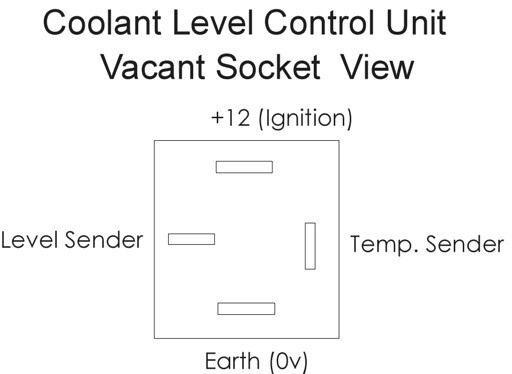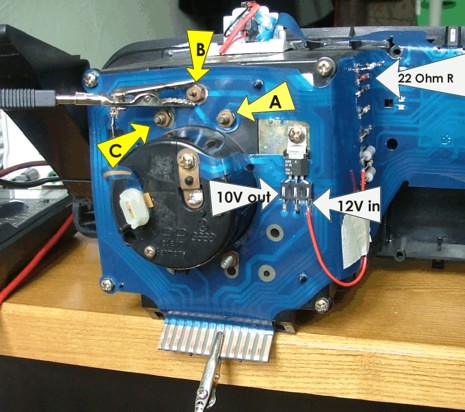voltage stabilizer
Moderators: User administrators, Moderators
voltage stabilizer
I have purchased a 1988 T25 camper van . In June last year. I have just replace the engine but find the engine runners at 3/4 on the temperature gauge. I have replaced the temperature sender, and the thermostat it made no difference. Having read that the voltage stabilizer controls the temperature and fuel gauge i decided to check it out. Can any one explain why i have a aluminum plate running from the centre of the stabilizer to the corner of the gauge . Is this a Earth of some sort. yours Hugo1988
- Oldiebut goodie
- Registered user
- Posts: 7295
- Joined: 18 Apr 2008, 01:19
- 80-90 Mem No: 11135
- Location: Eastern Angle
Re: voltage stabilizer
10v Voltage regulator, sounds like someone has replaced the original with a generic one which has to be mounted upside down due to the terminals being reversed. The plate will be a heat sink as the chip is now upside down to the norm.
1.6D 2019 VW T-Cross
200hp VW T6
1̶Y̶ ̶1̶9̶8̶7̶ ̶H̶i̶-̶t̶o̶p̶ ̶C̶a̶r̶a̶v̶e̶l̶l̶e̶
5̶0̶8̶d̶ ̶M̶e̶r̶c̶
200hp VW T6
1̶Y̶ ̶1̶9̶8̶7̶ ̶H̶i̶-̶t̶o̶p̶ ̶C̶a̶r̶a̶v̶e̶l̶l̶e̶
5̶0̶8̶d̶ ̶M̶e̶r̶c̶
- AngeloEvs
- Registered user
- Posts: 1345
- Joined: 22 Nov 2007, 19:22
- 80-90 Mem No: 4709
- Location: Upwell, Norfolk
Re: voltage stabilizer
A picture would help, as Oldiebut goodie points out, if the voltage regulator has been replaced with a non TCY type then it has to be mounted upside down with some form of support under the mounting tab.
The regulator mounting tab is the earth connection, as is the centre leg and both are connected together internally (and why earlier vans do not have the centre leg connected to anything). The regulator simply prevents the gauge needles fluctuating due to changes in the supply voltage.
Was the temp gauge reading differently with the previous engine with that regulator fitted? If the change has only happened with the new engine then I doubt it is the regulator but you can measure the output from the regulator by placing meter probes across the temp gauge mounting nuts. Measure across the smaller centre one (Earth) and the outer nut which connects to the regulator.
The regulator mounting tab is the earth connection, as is the centre leg and both are connected together internally (and why earlier vans do not have the centre leg connected to anything). The regulator simply prevents the gauge needles fluctuating due to changes in the supply voltage.
Was the temp gauge reading differently with the previous engine with that regulator fitted? If the change has only happened with the new engine then I doubt it is the regulator but you can measure the output from the regulator by placing meter probes across the temp gauge mounting nuts. Measure across the smaller centre one (Earth) and the outer nut which connects to the regulator.
1987 DG Karisma LPG with remodelled interior
Re: voltage stabilizer
Thank you for your replies regarding my voltage stabilizer. I have now purchased a 3 pin 1A 10v LM2940T-10.0 i will be fitting this shortly to see if this hopefully cures the problem . i will let you know at a later date . Hugo1988
- 123-jn
- Registered user
- Posts: 588
- Joined: 28 Mar 2013, 19:50
- 80-90 Mem No: 12161
- Location: Bromsgrove Worcstershire
Re: voltage stabilizer
L7810 is a standard 10v regulator (TO220) pin out looking at it with the heatsink behind left to right pin 1 in pin 2 Gnd pin 3 Out. Max current over 1A. This one works fine 5 for £1.50.
123-jn Autohomes Komet 2.1 DJ AUTO 1989 (closed loop LPG pierburg 2E3)
- Citroen C4 Picasso 1.6 HDi
- Citroen C4 Picasso 1.6 HDi
Re: voltage stabilizer
Well i have changed my voltage stabilizer with a new three pinned 1A 10v LM2940T. And guess what it's made it worse. Now instead of showing 3/4 it goes right across to the right. even after a very few miles.And i know the engine is not hot. Fuel gauge seems to be steady . Has anyone got an idea as to why this is happening before i change back to the putting aluminum strip back with a E 4B14 KA 7810.stabilizer. Or can it be a faulty gauge how can i check.
Hugo 1988
Hugo 1988
- AngeloEvs
- Registered user
- Posts: 1345
- Joined: 22 Nov 2007, 19:22
- 80-90 Mem No: 4709
- Location: Upwell, Norfolk
Re: voltage stabilizer
If the Voltage stabiliser is inserted incorrectly the output voltage will not be 10V but will be the supply voltage (12.7 to 13.8V) and eventually could fail. The guage will read higher due to the higher supply voltage.
Does the temp guage rise with just ignition 0n? If yes then you have a wiring fault
Check the wiring to the senders in the plastic thermostat housing in case of an error when you re-fitted the engine
Shown below is a rear view of the gauge panel . Using a Multimeter set to DC Volts, Measure the Voltage across points A and B (should be 10v)
The VW method for testing the Fuel and Temp gauges is by placing dummy loads across the output. The diagnostic tool used is connected to the horizonatal edge connector and simply places a resistor across the outputs - in the case of the Temp gauge it places a 100 ohm resistor across the output and the reading should be plus or minus one needle width from centre witha 10v supply. 100 ohms is the approximate value of the temp sender at normal operating temperature.
I carry out the test with the instrument cluster removed but it can be replicated on post 86 vans by removing the Module 43 (looks like a relay but is in fact an electronic circuit in a relay style housing and detects low coolant)- it is situated in the fuse box. (in earlier vans it is mounted elsewhere)
The module 43 can cause high temp readings if faulty so worth removing it as a preliminary test.
There are a two tests you can perform by inserting male spade connectors into the vacant sockets shown below and, with the use use of a multimeter read the resistance of the temp sender when your temp gauge is reading excessively high.
With engine cold, insert a 100 resistor into the vacant sockets shown and switch the ignition on (gauge reading should be centre or slightly above).
 socketv2 by Angelo Evans, on Flickr
socketv2 by Angelo Evans, on Flickr
 res90 by Angelo Evans, on Flickr
res90 by Angelo Evans, on Flickr
 rear90v4 by Angelo Evans, on Flickr
rear90v4 by Angelo Evans, on Flickr
Does the temp guage rise with just ignition 0n? If yes then you have a wiring fault
Check the wiring to the senders in the plastic thermostat housing in case of an error when you re-fitted the engine
Shown below is a rear view of the gauge panel . Using a Multimeter set to DC Volts, Measure the Voltage across points A and B (should be 10v)
The VW method for testing the Fuel and Temp gauges is by placing dummy loads across the output. The diagnostic tool used is connected to the horizonatal edge connector and simply places a resistor across the outputs - in the case of the Temp gauge it places a 100 ohm resistor across the output and the reading should be plus or minus one needle width from centre witha 10v supply. 100 ohms is the approximate value of the temp sender at normal operating temperature.
I carry out the test with the instrument cluster removed but it can be replicated on post 86 vans by removing the Module 43 (looks like a relay but is in fact an electronic circuit in a relay style housing and detects low coolant)- it is situated in the fuse box. (in earlier vans it is mounted elsewhere)
The module 43 can cause high temp readings if faulty so worth removing it as a preliminary test.
There are a two tests you can perform by inserting male spade connectors into the vacant sockets shown below and, with the use use of a multimeter read the resistance of the temp sender when your temp gauge is reading excessively high.
With engine cold, insert a 100 resistor into the vacant sockets shown and switch the ignition on (gauge reading should be centre or slightly above).
 socketv2 by Angelo Evans, on Flickr
socketv2 by Angelo Evans, on Flickr res90 by Angelo Evans, on Flickr
res90 by Angelo Evans, on Flickr rear90v4 by Angelo Evans, on Flickr
rear90v4 by Angelo Evans, on Flickr1987 DG Karisma LPG with remodelled interior
